In the intricate world of plumbing, terminology plays a crucial role in ensuring a task is done correctly and efficiently. One key term is “rough in” an early phase in the plumbing process that lays the groundwork for the final installation of fixtures. This stage is indispensable, setting the tone for the overall plumbing system’s success. Here you know: the rough in stage, its significance, common challenges faced, and the relationship between rough in and building codes.
Deep Dive into the “Rough In” Stage
The term “rough in” refers to the stage of construction during which the basic plumbing framework is laid out. It involves installing the water supply and drain pipes but stops short of connecting fixtures such as sinks, toilets, and tubs. The goal is to prepare for the final stage of plumbing installation when these fixtures will be installed and connected.
Professional plumbers play an integral role during the rough in stage, marking the locations for fixtures and ensuring pipes are correctly installed. Close collaboration with builders and architects is also crucial to align plumbing with the overall building design.
Importance of Rough In Measurements
Precision is critical in the rough in stage. Exact measurements determine the functional and efficient operation of the plumbing system. For example, the height at which a sink’s drain pipe is installed directly influences the sink’s usability and drain efficiency.
Standard measurements are generally used for different fixtures. A toilet, for instance, typically requires a 12-inch rough in measurement from the finished wall. Adhering to these standards, along with manufacturers’ recommendations and building codes, ensures optimal performance.
Errors during the rough in phase can compound down the line and significantly increase project timelines and budgets. If a bathroom sink drain is installed too high, for example, it may necessitate the repositioning of the drain, the removal of the vanity, and additional tile and wall repair. Incorrect measurements can also lead to inefficient plumbing systems, potentially causing water pressure problems, or worse, flooding.
Common Challenges during the Rough In Stage
The rough in stage, despite its importance, is not without potential obstacles. Layout or design problems can arise, and unforeseen obstacles like structural elements or pre-existing wiring can complicate the process. An experienced plumber is adept at troubleshooting these challenges, leveraging years of expertise to find effective solutions.
There are numerous challenges that a plumber may face during the rough in stage. Existing structures may not be plumb or square, requiring the plumber to adjust the planned layout. Additionally, initial plans may have to change if certain fixtures or materials are not available or if they have been updated or recalled since the design phase.
Adaptability is a crucial characteristic for a plumber during the rough in stage. Utilizing the latest technology and tools can greatly assist in overcoming obstacles. For instance, a digital blueprint can be updated in real time to reflect changes made on the ground.
The Connection between Rough In and Building Codes
Building codes exist to ensure the safety and integrity of construction projects, and they play a prominent role in the rough in phase. Plumbers must adhere to these codes, which specify everything from minimum pipe sizes to acceptable materials. Non-compliance can lead to penalties, project delays, and potential structural issues down the line.
Building codes not only dictate the specifications and standards for plumbing systems, but they also serve to protect the safety of the occupants and the community at large. For example, correctly installed plumbing prevents problems like water contamination and improper drainage.
During the rough in phase, adherence to these codes is paramount. Plumbing systems that do not conform to the building codes can lead to penalties, including fines and mandatory modifications. Even more importantly, non-compliance can create unsafe living conditions, highlighting the vital importance of following these codes.
Case Study: A Real-World Rough In Project
During the multi-story residential building project, the rough in stage took on heightened importance. This project had a high degree of complexity, as the plumbing systems had to cater to multiple units with different floor plans, all while ensuring optimal usage of space and resources.
The plumbers worked hand-in-hand with the builders and architects to make sure the plumbing layout aligned perfectly with the building’s design. During the rough in phase, they ensured that all measurements were precise, leaving no room for errors that could have led to costly and time-consuming revisions later.
The project serves as a testament to the significance of the rough in stage in plumbing. With meticulous implementation of this phase, the project completed successfully without any major hiccups in the plumbing system.
The Role of Inspection in the Rough In Phase
Rough in inspections are conducted to verify that the plumbing work complies with all applicable codes and regulations. During these inspections, aspects such as pipe placement, fixture alignment, and overall system layout are examined. Failing an inspection can lead to required revisions and additional costs. Rough in inspections serve to ensure that the work done up to that point is up to code. During the inspection, each component installed during the rough in phase is checked. This includes the piping for the DWV system, water supply lines, and stub out locations.
Failing a rough in inspection can result in the need for revisions, driving up project costs and extending timelines. In some cases, failed inspections can even halt construction until the necessary corrections are made. Therefore, a thorough and successful rough in inspection is a significant milestone in any construction project.
Conclusion
The rough in stage is a vital part of plumbing that requires precision, expertise, and careful planning. By understanding its role, associated challenges, and the importance of adhering to building codes, we can appreciate the critical groundwork this stage provides for the successful completion of any construction project. The quality of work done during the rough in phase sets the tone for the rest of the plumbing work, underscoring the saying, “Well begun is half done.”





